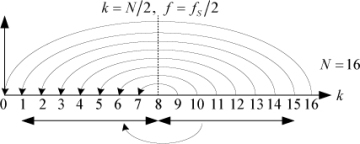Practical Applications in Digital Signal Processing: Review of Digital Frequency
It is easy to mathematically represent an analog frequency on paper. The range of frequencies in the analog domain is both continuous and theoretically infinite. If we use the symbol fO to represent some arbitrary analog frequency all we need to do is to equate it with any one of an infinite number of available frequencies. We could, for example, choose fO to be equal to 23.456 Hz, or we could just as easily choose fO to be equal to 1.005 MHz. We could choose just about any other value to any precision that we can dream up. As long as we remain realistic, there is no limit on the values that fO can take on.
However, a digital system operates on digital data and generates digital results that are valid only at discrete increments of time equal to the period of the system sample clock. Therefore the value that a digitally generated discrete frequency can take on is a small subset of the range of values available to analog frequencies. The discrete frequency values within this subset are directly related to and dependent on the sample rate of the digital system clock.
This leads to some confusion when people deal with digital frequencies for the first time. Much of the confusion can be summed up with three frequently asked questions:
- How do I define a digital frequency?
- How do I mathematically represent a digital frequency?
- How do I synthesize a digital frequency in hardware or software?
The scope of this chapter is to provide an answer for the first two of these questions. The answer to question number 3 requires its own chapter and is dealt with in detail in Chapter 8, “Digital Frequency Synthesis.”
1.1. Definitions
In this chapter, we will make the following symbol definitions:
- f defines any arbitrary analog frequency in hertz.
- fO defines a specific analog frequency in hertz.
- fK defines a specific digital frequency in hertz.
- ωO defines a specific analog radian frequency in radians/second.
- ωK defines a specific digital radian frequency in radians/second.
- fS defines the sample rate or the frequency of a digital system clock.
- T defines the period of the digital sample clock T = 1/fS.
